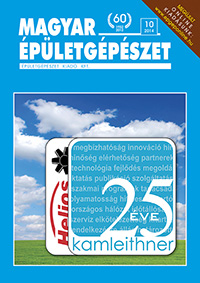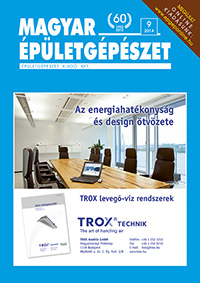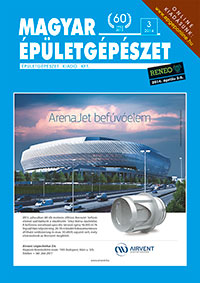Lapszámok

2014 11. szám
- Virág Zoltán:
Többdimenziós tervezési folyamat az épületgépészetben - Dr. Böszörményi László:
Családi ház energetikai minőségének vizsgálata különböző hőellátási megoldások alkalmazásánál – 1. rész - Csík Árpád PhD:
Épületek energetikai felújításának gépi optimalizációja: összehasonlító esettanulmány - Tóth Bence - Dr. Vad János:
Ipari axiális ventilátorok akusztikai diagnosztikája - Székely Tamás:
Energia megtakarítási esettanulmány PIBCV technológia alkalmazásával fan-coil készülékek üzeménél - Panasonic Marketing Europe GmbH South-East Europe Branch Office:
A Panasonic új hűtőközeg visszafejtő rendszere – Gyors reagálás a szivárgásra - Erdei István:
Használati melegvíz hálózatok szivattyútechnikája - Szabó Tamás:
Fagyasztókamrák jegesedési/párásodási problémák nélkül? - Grundfos South East Europe Kft.:
Grundfos szennyvízátemelő berendezések - Nyárády Győző:
Kihozható-e több a napkollektoros rendszerekből? – A használati melegvíz termeléstől a részleges szolár fűtésig - Rébay Lajos:
Tanulságos életpályák – Nemcsik Ambrus - Colt Hungária Kft.:
Adiabatikus hűtés ipari csarnokokban - Németh Gábor:
Épületgépészeti oktatás – maximális hatékonysággal
Hozzászólások
Épületek energetikai felújításának gépi optimalizációja: összehasonlító esettanulmány
Még nem érkezett hozzászólás!
Csík Árpád PhD
Épületek energetikai felújításának gépi optimalizációja: összehasonlító esettanulmány
Absztrakt
Jelen publikációban a számítógéppel támogatott épületenergetikai optimalizáció, mint új generációs, hatékonyságot maximalizáló technológia kerül bemutatásra. Alkalmazási területként lakóépületek költséghatékony felújításának tervezését célozzuk. Az ismertetett diagnosztikai és tervező eljárások szakszerű használata meghatározó mértékű csökkenést eredményez egy felújított épület üzemeltetéséhez kapcsolódó költség, energiaigény, valamint társítható környezeti terhelés vonatkozásában.
A hétköznapi gyakorlatban rendelkezésre álló eszköztár demonstrációja céljából az EnergOpt szakértői rendszer alkalmazásával bemutatjuk egy családi ház optimalizált költséghatékony felújításának tervezési folyamatát. A rendszer által kiaknázható megtakarítási potenciál nagyságrendjének érzékeltetése céljából összehasonlító tanulmányt közlünk a pusztán szakmai tapasztalaton alapuló és a gépi optimalizációval támogatott mérnöki tervezés hatékonyságáról. A technológia által képviselt lehetőségek és korlátok pontosabb megismerése végett részletezzük a gyakorlati alkalmazáshoz szükséges alapkövetelményeket és ismertetünk néhány potenciális alkalmazási területet.
1. Introduction
Efficiency is a key principle in the field of building refurbishments. According to statistical data representing Hungary, approximately 3 000 000 out of 4 300 000 homes require some level of energetic improvement. There are several tools available to increase the efficiency of refurbished buildings. Some of them are widely recognized, while others require more attention. Increasing the efficiency of heat production systems, creating cheap, quality insulators, increasing the ratio of renewable energy sources, and improving building policies and financial support systems at the EU and national levels are well recognized methods to moderate the financial, energetic and environmental burden of the building sector.
In the last decade computer aided energetic optimization of building refurbishments has emerged as a powerful tool to give a boost to efficiency increase. Though the technique carries a potentially great impact to the field, nowadays it is far from being properly recognized. Even the concept of optimization is often misinterpreted by industry experts and academic professionals. According to common practice, for a particular building subject to refurbishment a couple of designs are created by human experts and the client has the option to select the one fitting best to the actual needs. This approach should certainly not referred to as optimization, since it remains at the level of efficiency increase by trial and error.
The theoretical background of computer aided optimization is a well-developed field of applied mathematics. It provides algorithms for the approximation of the global extremum of functions defined over huge search spaces. A recent review of these techniques applied in the field of building optimization can be found in (Evins, 2013). There are more than a dozen techniques available to compute the parameters of optimized refurbishment design. However, extensive real life applications demand more than running sophisticated algorithms for demonstration purposes. The problem has to be treated at the system level, requiring to deal with issues like complex data structure, large databases, case dependent workflow, computational efficiency, etc.
The aim of this paper is threefold. First, we present the optimization of building refurbishment as a mature technology, ready to be employed in industrial applications. Second, we present and apply the highly customizable ENERGOPT expert system for the optimization of a refurbishment design and compare the results with the work of a human expert. The third goal is to describe the prerequisites of the system’s dissemination at the industrial level.
The structure of the paper is the following. In section 2 we provide the problem definition. In section 3 we give a brief review of the ENERGOPT expert system. In section 4 the refurbishment design of a family dwelling is presented and analyzed to illustrate the performance of the system. In section 5 we study the prerequisites of the technology facilitating practical implementations. In section 6 potential applications are highlighted. Finally, in section 7 concluding remarks are given.
A cikk a XX. Épületgépészeti Szakmai Napok második napján tartott nemzetközi konferencia kiadványában megjelent előadás alapján készült, a „Fenntartható energetika megújuló energiaforrások optimalizált integrálásával” című TÁMOP-4.2.2.A-11/1/KONV-2012-0041 nemzetközi projekt keretében végzett vizsgálatok alapján. Beszámolónkat lásd a 27. oldalon.
További részletek lapunk 2014/11-es számának nyomtatott változatában található, illetve a teljes cikk pdf-formátumban is rendelkezésre áll (regisztráltaknak havonta egy alkalommal, előfizetőknek korlátlanul).









